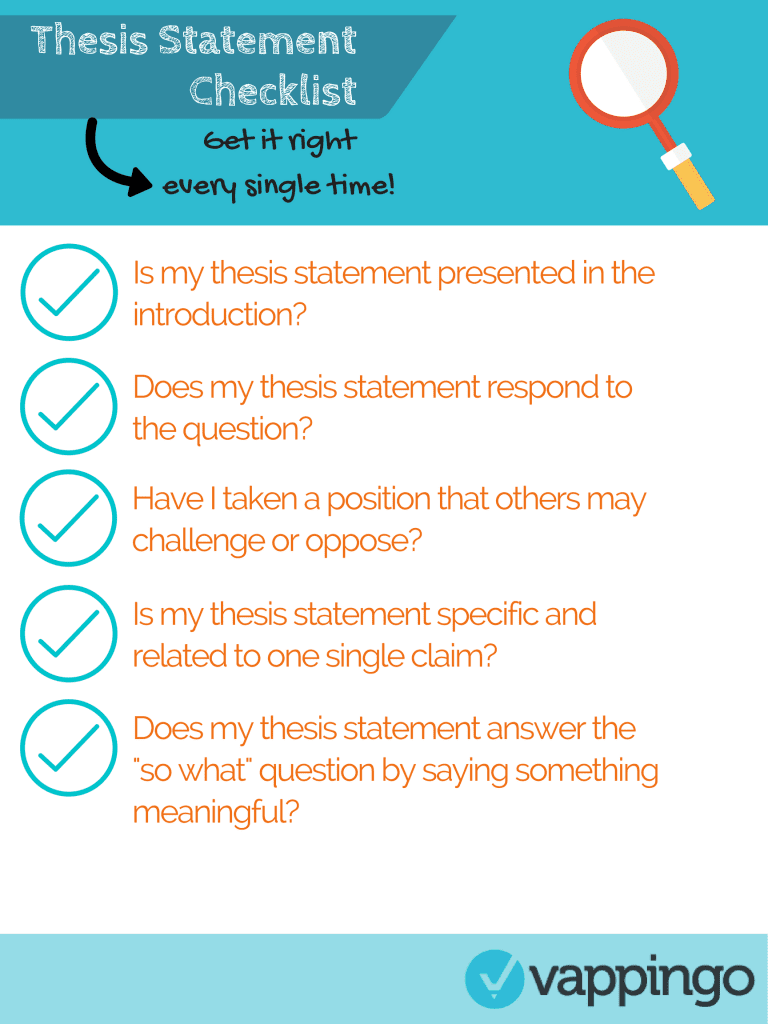Looking at examples of thesis statements can be helpful when you’re crafting a thesis statement to guide your essay.

We’ve already looked at how to write a thesis statement and the thesis statement formula. In this article, we’ll present a ton of examples of solid thesis statements for a range of different subjects.
If you’ve yet to decide on your research topic, take a look at our 85 examples of great dissertation research topics.
When you read through them, you should start to see a pattern emerge in terms of how they typically adhere to the following set of rules:
- A single sentence located at the end of your essay introduction
- The thesis statement summarizes what your opinion is and what you are going to explore.
- Directs your reader to the main arguments you will present.
A good dissertation proofreader will be able to help you ensure your thesis statement is strong and structured properly.
Alternatively, you could tap into the powers of AI and use this excellent thesis statement generator:
Can a Thesis Statement Include More Than One Question?
A thesis statement does not need to be a single sentence. The length of your thesis statement will vary according to the complexity of the subject you are exploring.
In some cases, a solid thesis statement will consist of a single sentence. However, in other cases, you may use two, or even three, sentences.
Your overall aim should be to ensure the statement is as short and direct as possible, as this will help you to appear confident. This is particularly important in an argumentative thesis statement for argumentative essays.
Let’s remind ourselves of the basics of a good thesis statement.
How to write a thesis statement checklist:

For ideas on how to use the thesis statement within your essay, take a look at our thesis paragraph examples.
70 Strong Thesis Statement Examples for Research Papers and Dissertations
Now we’ve covered the basis, let’s take a look at some really great examples of thesis statements you can use when writing a thesis.
15 Example Thesis Statements on the Social Sciences
- Climate change is a pressing global issue that requires immediate action, as it threatens to undermine the stability of entire ecosystems, disrupt economies, and jeopardize the health and well-being of future generations.
- The role of technology in education cannot be underestimated because it has the potential to transform the learning experience, enhance the quality of education, and provide students with access to information and resources that were previously unavailable.
- The use of renewable energy sources such as solar, wind, and hydropower is crucial to achieving a sustainable future, as it reduces dependence on finite resources, minimizes greenhouse gas emissions, and protects the environment.
- The widespread prevalence of fake news and misinformation on social media is a growing concern, as it undermines the credibility of journalism, public trust in information, and the democratic process.
- The rise of automation and artificial intelligence in the workplace is transforming the way people work, leading to increased productivity and efficiency; however, it is also linked with job displacement and the need for workers to acquire new skills.
- The intersection of race, gender, and class has a significant impact on a person’s life opportunities and experiences, and it is crucial to understand these intersections in order to address systemic inequalities and promote social justice.
- The growing demand for food and the increasing use of industrial agriculture are putting a strain on the environment, leading to soil degradation, deforestation, and increased greenhouse gas emissions.
- The phenomenon of gentrification is transforming cities, leading to the displacement of low-income communities, the loss of cultural diversity, and the commodification of urban spaces.
- The impact of mass migration on countries and communities is complex and far-reaching, leading to both cultural enrichment and increased social and political tensions.
- The growing concern about income inequality and wealth disparity has important implications for social and economic mobility, as well as for the stability of democracies and the legitimacy of political systems.
- The rise of nationalism and populism around the world is challenging the stability of global institutions and the foundations of democratic systems. It raises important questions about the role of the nation-state in the 21st century.
- Elon Musk, the billionaire entrepreneur and innovator, has made a significant impact on the tech industry and the world as a whole through his numerous ventures and ambitious projects, making him a visionary leader and a symbol of technological progress. However, his actions and public statements have also generated controversy and criticism, calling into question the ethical and social implications of his vision for the future.
- Bitcoin, the decentralized digital currency, has revolutionized the financial industry and challenged traditional financial systems. However, the growing popularity and acceptance of Bitcoin has also brought to light important issues regarding security, regulation, and the potential for negative impacts on the economy and society as a whole.
- Quantum computing, a rapidly evolving field that harnesses the principles of quantum mechanics to perform calculations, has the potential to revolutionize the computing industry and solve complex problems that are beyond the capabilities of traditional computers; however, quantum computing poses a significant threat to contemporary society that should not be overlooked.
- Electric cars have emerged as a promising alternative to traditional gasoline-powered vehicles, holding great promise for reducing humanity’s dependence on fossil fuels. However, this technology is not sustainable or viable on a long-term basis
15 Sample Thesis Statements for Literary Analysis Essays
- The political and social developments of the 18th century had a significant impact on the development of the English novel, which reflected both the ideals and the realities of the time.
- The Romantic movement in English literature constituted a notable divergence from the Enlightenment ideas of reason and order by emphasizing emotion, imagination, and individualism.
- Although Jane Austen is well known for her wit and social satire, her writings also serve as a commentary on the discrimination that women encountered in early 19th-century England.
- The manner in which authors of the Victorian era portrayed non-European cultures and peoples is one way to show how colonialism and imperialism had an impact on English literature.
- The literature of the Victorian era reflects the position of women in English society at the time, with female characters frequently acting as icons of moral and cultural values.
- The use of symbolism within English literature serves as a potent instrument for examining complicated themes and ideas, from the profound to the ridiculous.
- When writers like James Joyce and Virginia Woolf introduced the stream-of-consciousness narrative approach, the English novel underwent a revolution that allowed for a new degree of depth and reflection in storytelling.
- The writings of English Romantic poets, like William Wordsworth and Samuel Taylor Coleridge, marked a turning point in the development of English literature by ushering in a novel kind of writing that praised the natural world, human emotion, and unique experiences.
- From Beowulf to Paradise Lost, the evolution of the English epic poem reflects the shifting morals and ideologies of English society over time, as well as its changing perception of who we are and where we belong in the world.
- The three Bronte sisters—Charlotte, Emily, and Anne—used literature to question the restrictions and standards that were imposed on women in 19th-century England, setting a new precedent for female emancipation.
- With its rigid structure and rhyme schemes, the English sonnet tradition has been a well-liked and enduring manner to convey one’s thoughts on both the political and personal levels as well as the human condition.
- With its emphasis on experimentation, fragmentation, and psychological depth, the Modernist movement in English literature marked a significant shift from the realism and naturalism of older literary traditions.
- The evolution of English literature in the 20th century was greatly influenced by the writings of T.S. Eliot and W.B. Yeats, which capture the period’s intellectual and cultural upheaval as well as the significant changes evident in European society.
- The expansion of the English empire and its influence over the world had a significant impact on the literature of the nation, influencing new kinds of storytelling as well as the themes, writing techniques, and perspectives of its authors.
- From the biblical account of the Fall to the Greek myth of Orpheus and Eurydice, the use of allegory and myth in English literature has been a potent means of examining difficult concepts and universal truths.
Try our free ai essay generator to create a full sample essay.
10 Sample Thesis Statements on History
- Beginning in 1789, the French Revolution marked a significant turning point in European history that eventually resulted in the collapse of the monarchy and the foundation of a democratic republic.
- The American Civil War, which took place between 1861 and 1865, was a pivotal event in the history of the nation, influencing its political structure, identity, and values for a number of years.
- An important turning point in world economic and social history, the Industrial Revolution, which started in England in the late 18th century, fundamentally changed how products were created and consumed, leading to significant changes in the lives of people all over the world.
- One of the biggest and most influential empires in history, the Roman Empire, which ruled from 27 BC to 476 AD, had an impact on the growth of art, architecture, law, and language throughout the Mediterranean region.
- The Enlightenment, an intellectual and cultural movement that began in Europe in the 18th century, represented an important turning point in the history of ideas and gave rise to new ways of thinking about politics, religion, and society.
- One of the deadliest and most significant conflicts in modern history, the First World War, which raged from 1914 to 1918, drastically altered the political, social, and economic climate of Europe and other parts of the world.
- The Cold War, which lasted from 1945 to 1991, marked a pivotal period in the history of the 20th century, impacting the advancement of science, technology, and culture as well as the political and military landscape of the world.
- The 1754–1763 French and Indian War was a pivotal period in the history of the American colonies, paving the way for the ultimate independence of the United States and determining the course of the nation’s future.
- Capitalism, which first appeared in Europe in the 16th and 17th centuries, marked a significant turning point in the development of modern market economies and the lives of millions of people.
- An important turning point in the history of the American colonies was the American Revolution, which took place between 1775 and 1783 and ultimately resulted in the independence of the United States and the development of a new system of government.
10 Example Thesis Statements on Art
- The Italian Renaissance, which started in the 14th century and lasted until the 17th, was a time of great artistic and cultural revival. The painting, sculpture, and architectural expressions that emerged during this time had a significant influence on Western art and culture.
- A time of great artistic and cultural diversity, the Baroque period was characterized by the emergence of new forms of artistic expression, such as painting, sculpture, and music, that reflected the religious, political, and cultural values of the day.
- The late 19th-century French Impressionist style was a ground-breaking trend in painting that aimed to represent the fleeting, transient effects of light and color in the natural world.
- Mid-20th-century modern art movement known as Abstract Expressionism, which emphasized spontaneous, expressive brushwork and explored the emotional and psychological components of the creative process, was a prominent force in the world of contemporary art.
- Pop Art, a modern art movement that began in the middle of the 20th century in response to the Abstract Expressionist movement, was distinguished by its use of common objects, commercial imagery, and vibrant colors to produce a fresh kind of art that was approachable and pertinent to popular culture.
- Surrealism, a modern art movement that began in the 1920s, used methods like automatic drawing and dream-like images to produce a new kind of work that was both strange and enticing while prompting an investigation of the subconscious mind.
- The 1920s and 1930s saw the emergence of the Art Deco movement, which aspired to create a new genre of modern art that was elegant, sophisticated, and representative of the contemporary world. It was distinguished by its use of geometric shapes, brilliant colors, and metallic finishes.
- Gothic Art, a key influence on Medieval art that first appeared in the 12th century, is known for its concentration on lofty cathedrals, exquisite stained glass, and ornate sculptures that capture the period’s religious and cultural values.
- The Romanesque period was a time of great artistic and cultural rebirth. Painting, sculpture, and architectural styles all emerged during this time, and they had a significant influence on Western art and culture.
- The 19th-century art movement known as realism tried to portray the world as it actually was by employing precise, lifelike depictions of people, places, and things to produce a new kind of art that was both realistic and compelling on an emotional level.
15 Examples of English Language Thesis Statements
- Due to historical, cultural, and social influences on the development of the English language, numerous dialects and variations have emerged all over the world.
For individuals, groups, and cultures, the emergence of English as a world language has yielded both benefits and challenges and had a profound impact on global language education and language policy. - Understanding the structure, purposes, and meanings of English allows us to better comprehend how language both influences and is influenced by human cognition, perception, and interaction.
- The widespread use of English in digital communication and social media has given rise to new linguistic elements and conventions, like emoticons, acronyms, and hashtags, which have significantly changed how our ability to express ourselves and interact with others.
- The English language has taken on a greater significance in higher education because it is frequently the language of instruction and research in many academic subjects and is necessary for worldwide communication and collaboration.
- Studying English as a second or foreign language requires not only learning linguistic abilities but also gaining intercultural competence and the capacity to deal with diversity and cultural differences.
- The influence of the English language on other languages has led to phenomena such as word borrowing, grammar borrowing, and punctuation changes. This has led to a fundamental change in language boundaries and the emergence of hybrid forms of language.
- English usage in the workplace has become crucial for successful communication and career advancement, especially in multinational organizations and international industries. This has resulted in the growth of specialized linguistic abilities and discourse patterns.
- Language diversity and linguistic justice have become ethical and political hot topics as a result of how English has affected the identities and cultural practices of speakers of other languages, led to the extinction of indigenous languages, and initiated negotiations over language rights and language maintenance.
- Understanding the cultural, historical, and social circumstances in which literary works were created helps us to examine and interpret the literary works’ artistic and aesthetic qualities as well as its larger relevance and societal effects.
- The widespread use of English in popular culture, such as music, film, and television, has significantly influenced the language’s acceptance around the world and sparked the development of new genres, styles, and modes of expression.
- By studying English as a discourse community and examining its norms, practices, and communication techniques, it is possible to get insight into the power structures and social hierarchies that influence how people use language and formulate language ideologies.
- English’s use in the tourism sector as a universal language and a vehicle for cross-cultural engagement has had economic and social repercussions for both host communities and guests, sparking discussions about how globalization is affecting regional cultures and identities.
- English should be taught to all children since it not only fosters language proficiency but also creativity, social responsibility, and critical thinking.
- The impact of English on the linguistic landscape of cities and communities, including the use of English in media, ads, and public signs, reflects language interaction dynamics and the negotiation of linguistic identities and rights.
- The impact of English on the linguistic landscape of cities and communities, including the use of English in public signs, advertisements, and media, reflects the dynamics of language contact and the negotiation of linguistic identities and rights.
As you will see from all the example thesis statements shared above, a solid thesis statement follows a general formula.

